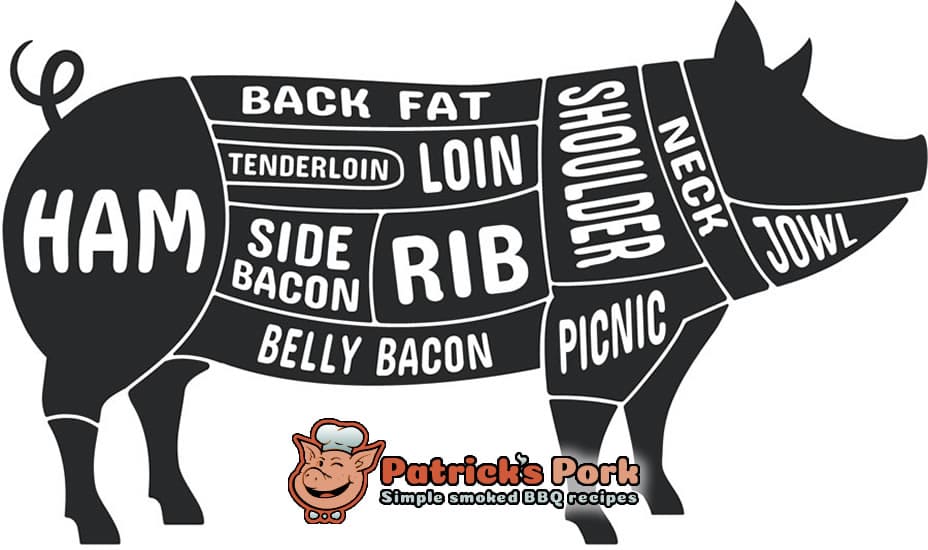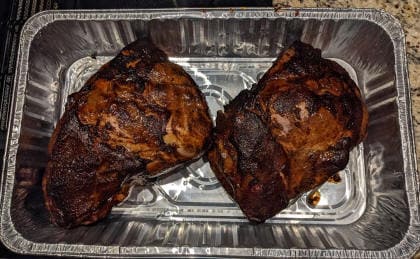Intro to Smoking Pork
What is hot smoked pork BBQ cooking?
Here are the basics of BBQ pitmastery.
BBQ smoking is a cooking technique that exposes pork to both heat
and wood smoke, cooking
it and giving it flavor at the same time. The smoking process can take
between up to 20 hours, depending on the size of the pork roast and
the consistency of heat in the smoker. The internal temperature
of the pork should reach at least 195 degrees.
Types of "heat sources" that generate smoke
Several types of fuels are used in
BBQ smokers to generate heat
and smoke. Here are some of the more popular options:
- Charcoal: Charcoal is a classic and widely
used fuel for BBQ smokers. It is made by burning wood in a low-oxygen
environment, resulting in charred remains. Charcoal briquettes are
a common form of charcoal used by smokers due to their consistent
burn and longer-lasting heat. Lump charcoal, which consists of irregularly
shaped pieces of charred wood, is another option favored for its
natural flavor and quick ignition.
- Electric: Electric smokers rely on electricity
as their power source. Heating elements within the smoker generate
heat, while wood chips, chunks, or sawdust are added to produce
smoke. Electric smokers are known for their convenience and ease
of use, requiring minimal monitoring and maintenance.
- Pellets: Wood pellets are cylindrical-shaped
compressed wood particles made from sawdust or wood chips. Pellet
smokers/grills are designed to use these pellets as the primary
fuel source. Pellets offer convenience and precise temperature control
while providing a variety of wood flavors for smoking.
- Propane: Propane is a popular fuel for gas
smokers. Propane tanks supply the necessary heat to cook food and
produce smoke. Propane smokers are convenient and easy to use, as
they allow for quick heat-up times and temperature control with
the turn of a knob. However, it's important to note that while propane
smokers provide heat, additional wood chips or chunks are typically
added to produce smoke and enhance the flavor.
- Wood:
Wood is arguably the most traditional fuel for BBQ smokers, known
for providing rich and distinctive smoke flavors. Different types
of wood impart unique flavors to the meat, such as hickory, mesquite,
apple, cherry, oak, and pecan. Smokers use wood chunks, chips, or
pellets to generate smoke and contribute to flavor.

Which cuts of pork can be smoked?
The best cuts of pork to smoke are generally fatty cuts. The high
fat content helps keep the pork moist and tender.
- Pork Butt/Shoulder: This is cut from the upper
shoulder of the pig. It is well-marbled with fat and contains a
lot of connective tissue. It is often used for
pulled pork, slow cooking,
roasting, or braising.
- Pork Loin: The pork loin is a lean, tender
cut along the pig's back. It is known for its tenderness and can
be prepared as boneless or bone-in roasts, chops, or medallions.
It is suitable for grilling, smoking, or
frying.
- Pork Ribs: Pork ribs typically come from the
pig's ribcage and are known for their rich flavor and tenderness.
They can be divided into two main types: baby back ribs (upper ribcage)
and spare ribs (lower
ribcage). They are often cooked by grilling, smoking, or
baking.
- Pork Chop: Pork chops are cut perpendicular
to the spine, usually from the loin or rib area. They can be bone-in
or boneless and come in various thicknesses. Pork chops are versatile
and can be cooked through grilling, pan-frying, baking, or broiling.
- Pork Belly: Pork belly is a fatty and flavorful
cut taken from the pig's underside. It contains layers of fat and
meat and is commonly used to make bacon. It is also used in various
cuisines for braised or crispy pork belly dishes.
- Pork Tenderloin: The pork tenderloin is a lean
and tender cut that runs along the backbone. It is one of the most
tender cuts of pork and is ideal for quick cooking methods like
grilling, roasting, or sautéing.
- Fresh Hams and Picnics: These large pork cuts
come from the pig's hind leg. Fresh hams and picnics are often used
to make ham, but they can also be smoked, roasted or boiled for
different dishes.
- Pork Chops and Steaks: This term refers to
pork cuts sliced into individual chops or steaks. They can come
from various parts of the pig, including the loin, rib, or shoulder.
The cooking method for pork chops and steaks depends on the specific
cut and thickness.
- Pork Shanks: Pork shanks are cuts taken from
the lower leg portion of the pig. They are relatively tough and
contain a lot of connective tissue. They are commonly used in slow-cooked
dishes, such as stews, braises, or soups, where the connective tissue
breaks down and adds flavor.
How long does it take to smoke pork?
Cooking times for smoking BBQ pork can vary depending on the cut
of pork, the size, and the smoker's temperature. Here are some general
guidelines for popular cuts of pork:
Pork Shoulder (Pork
Butt):
Size: 6 to 8 pounds
Smoking Temperature: 195-225°F
Estimated
Cooking Time: 1.5 to 2 hours per pound
Total Cook Time: 8 to 20 hours
For pulled pork, you want an internal temperature of around 195-205°F
for the meat to be tender and easy to pull.
Pork Ribs (Spare
Ribs or Baby Back Ribs):
Size: 2.5 to 3.5 pounds for spare ribs, slightly less for baby back
ribs
Smoking Temperature: 215-250°F
Estimated Cooking Time: 3
to 6 hours for spare ribs, 2.5 to 4 hours for baby back ribs
Pork Tenderloin:
Size: 1 to 2 pounds
Smoking Temperature: 215-250°F
Estimated
Cooking Time: 1.5 to 2 hours
These are only general estimates, and the actual cooking time can
be influenced by various factors such as the smoker's efficiency, outdoor
temperature, and the cut of meat. To ensure the pork is cooked properly,
it's recommended to use a thermometer to check the internal temp.
Cooking Chart
Remember the saying... "if you’re looking, you ain’t
cooking." When you open the lid of your smoker, you are letting out heat and smoke which can add to the cook time.
| PORK CUT |
TOTAL COOK TIME |
SMOKER TEMP |
| Pork ribs |
2.5-6 hours |
215-250° F |
| Pork butt / Picnic / Shoulder |
4-5 hours for smoke; wrap and
cook additional 7-8 hours |
195-225° F |
| Pork loin |
1.5-2 hours |
215-250° F |
| Pork chops |
45 min-1 hour |
225-250° F |
| Pork belly |
4 hours for smoke; wrap and
cook additional 3 hours |
225-250° F |
Is pork is healthy?
Yes! Pork is a versatile and nutrient-dense meat providing some essential
nutrients. Pork is also keto friendly because it is low in
carbs and high in protein.
Here is an overview of the nutritional composition of pork
per 100 grams (3.5 oz) of cooked, smoked meat:
- Calories: Approximately 250-300 calories, depending
on the cut and cooking method.
- Protein: Pork is a good source of high-quality
protein, providing about 25-30 grams per 100 grams. Protein is essential
for building and repairing tissues, supporting immune function,
and maintaining healthy muscles.
- Fat: Pork contains varying amounts of fat,
depending on the cut and trimming. Generally, lean cuts like pork
tenderloin have less fat, while cuts like pork belly or ribs have
higher fat content. Pork fat contains a mix of saturated and unsaturated
fats. For example, pork tenderloin contains about 3 grams of fat
per 100 grams, with less than 1 gram of saturated fat.
- Vitamins: Pork is a good source of various
B vitamins, including thiamine (B1), riboflavin (B2), niacin (B3),
vitamin B6, and vitamin B12. These vitamins are essential in energy
metabolism, nervous system function, and red blood cell production.
- Minerals: Pork provides essential minerals
such as iron, zinc, selenium, and phosphorus. Iron is crucial for
oxygen transport, while zinc is involved in immune function and
wound healing. Selenium acts as an antioxidant, and phosphorus contributes
to bone health.
- Other Nutrients: Pork also contains small amounts
of potassium, magnesium, and vitamin D.
Tips for buying a quality cut of pork from the store
Selecting a good cut of pork involves evaluating factors like the
meat's appearance, color, marbling, and overall freshness. Here are
some tips to help you choose a high-quality cut:
- Color and Appearance: Look for pork cuts
that are pinkish-red. Avoid meat that is pale or has a grayish hue.
The fat should be creamy white and evenly distributed throughout
the meat.
- Marbling: Marbling refers to the small
streaks of fat running through the meat. Good marbling enhances
the flavor and juiciness of the pork. Look for cuts with fine lines
of fat evenly distributed throughout the meat.
- Firmness: Gently press the meat with your
fingers. It should be firm and spring back when touched, indicating
freshness. Avoid meat that feels overly soft or mushy.
- Odor: Fresh pork should have little to
no smell. If the meat has a strong, unpleasant odor, this is a red
flag, it might be spoiled!
- Sell-by Date: If the meat is packaged,
check the sell-by date to ensure it's within the recommended freshness
period.
- Ask the Butcher: If you have specific
cooking needs or preferences, don't hesitate to ask the butcher
for advice. They can recommend the best cuts for your intended
recipe.
- Bone-in vs. Boneless: Bone-in cuts have
more flavor and moisture, while boneless cuts can be easier to handle
and cook.
- Consider the Recipe: Different cuts of
pork are suitable for various recipes. For example, pork chops are
great for grilling, while pork shoulder is ideal for slow-cooking
and pulled pork.
Healthy pork prep reminders
Remember, when handling raw pork, always follow these food safety
practices to prevent cross-contamination and ensure safe consumption.
- Wash hands, all utensils, containers, cutting boards, and
work surfaces with warm, soapy water for 20 seconds (count to
30) before and after handling food.
- Thaw pork in the refrigerator or microwave, not at
room temperature.
- Do not wash raw pork before cooking.
- Cook pork immediately after thawing, especially if
thawed by microwaving.
- An instant-read thermometer determines when pork is cooked
to a safe temperature. Correctly cooked pork is juicy and
tender, with a slight blush of pink in the center, and will be
ready when it reaches an internal temperature of 160°F. For
large cuts of pork, cook to 150°F and allow the roast to sit on
the counter for about 10 minutes before cutting. The temperature
will rise to 160°F.
- Keep hot foods hot (140° F or above) and cold foods cold
(40° F or below).
- Don't leave cooked meat at room temperature for over two
hours (one hour in hot weather, 90° F or above).
- Cut meat, poultry, and fish on a separate cutting
board from the one you use for fresh foods like vegetables, or
clean the cutting board between uses.
- Serve cooked food on a clean plate and use clean utensils.
Use separate serving plates and utensils for raw and cooked
meats.

